Seth Thomas, Weight Driven Clock with Early US Symbol (1855 – 1860)
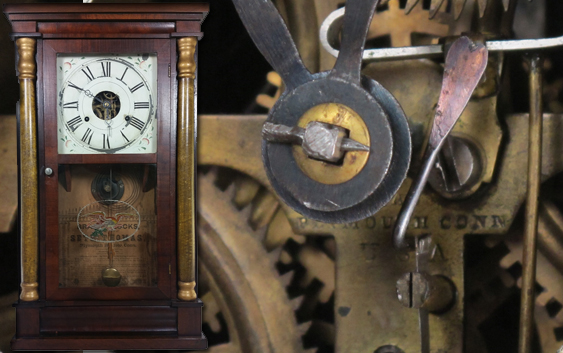
I recently acquired a Seth Thomas, weight driven, mantel clock. Mantel clocks are not rare. You can walk into just about any junk store and find an old, functioning mantel clock. Where it gets exciting is when you can place the clock to a particular time period (Civil War, WWI, WWII, etc.). In this case, the clock had a distinctive eagle on the front holding the classic arrows and olive branches. The eagle’s head is down in an aggressive pose as apposed to the current US symbol where the eagle is in a majestic defensive position. Could this be an American Civil War era Union clock? I have seen clothing buttons and other items with a similar symbol. OH, man I am excited.
First, let me start by letting you see the clock in action. It is crazy fun to watch.
Civil War or Not Civil War?
I get a lot of questions from people who ask how to date various items. Thanks to the internet, the tedious process is made much easier thanks to the generous and patient devotion of people who specialize in particular areas. Clocks are especially fun to place on the historical timeline since they tend to be well documented and with a little digging you should be able to get a fairly accurate production date range. So let’s answer the big question: Is this a civil war era clock?
Step 1: Was the Seth Thomas Clock Company in business during the Revolutionary War timeframe?
One of the fun things about clock collecting is the abundant information and Seth Thomas is one of my favorites. The Seth Thomas Clock Company was in business from 1853 to 2001. There are a multitude of sites dedicated to Seth Thomas and I encourage you to visit them; however, for the purposes of this post it is our first important piece of information. Namely Seth Thomas himself was actively building clocks during the Civil War period (1861 to 1865).
Step 2: Does the case give us any clues?
Pre-1900 cases hold a wealth of information. Based on the paper label, the clock in question is a type 2, half column, Thirty Hour Brass Movement Weight Driven Clock. Luckily the paper label inside the clock is intact and we can see the label has a key identifier: Steam Press of Elihu Geer, 16 State Street, Hartford, Conn.
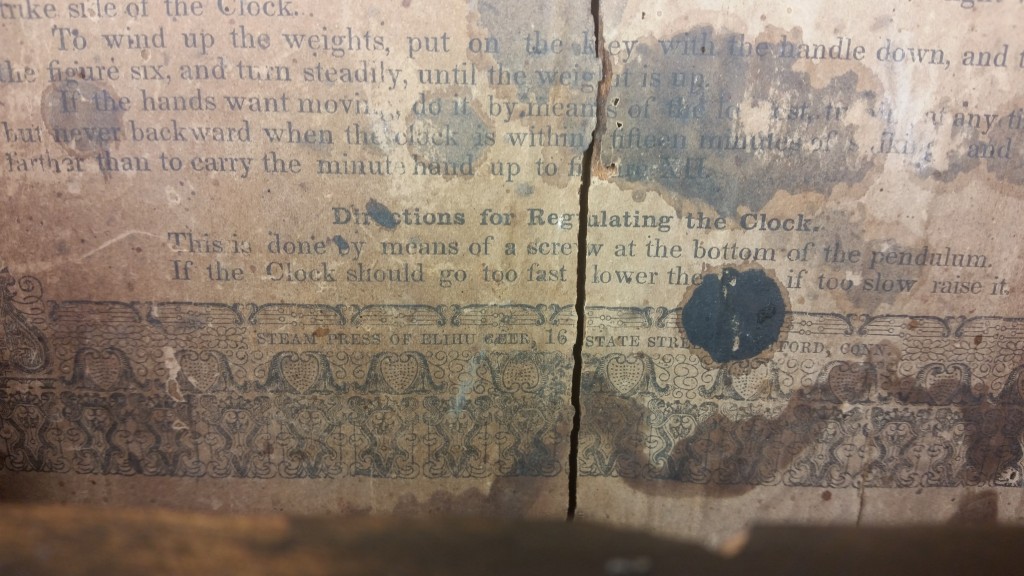
Steam Press of Elihu Geer, 16 State Street, Hartford, Conn.
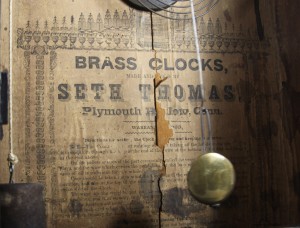
With a quick google search, it was easy to find that the Elihu Greer, 16 State Street label was used from 1856 – 1865.
Even without the paper label, there were many sites that made it easy to identify the case based on the half column design and distinctive weight driven design. Generally you can get decent results by combining the manufacturer name and learning a few of the terms related to the clock (weight driven, mantel clock, etc). For example, google searches for words like:
- Seth Thomas weight clock
- Seth Thomas two column case
- Early Seth Thomas mantel clocks
Consulting some old fashion books and hitting the internet, the case matches the information gleaned from the paper label.
And finally, the reverse painted eagle on the glass was apparently a widely used symbol before, after and during the Civil War. I can find examples on other clocks. Looking closely at the paint, you can see that it has a stencil like quality to it. While that does help narrow the time, it does not necessarily indicate that the stencil is from the Civil War period.
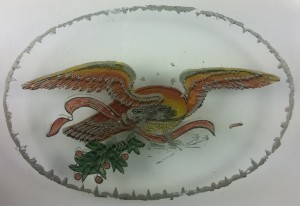
Not bad, but not definitive. The Civil War was from 1861 to 1865. So let’s go deeper.
Step 3: Does the movement give us any clues?
The movement is generally the key to narrowly dating a piece. If you can get a look at the full movement and access to the hallmarks, manufacture information, etc…, you can generally further narrow the date. Lucky for us, the movement is well known and some key identifiers are in plain sight.
Here are a few easily seen identifiers:
S. Thomas
Plymouth Conn
USA
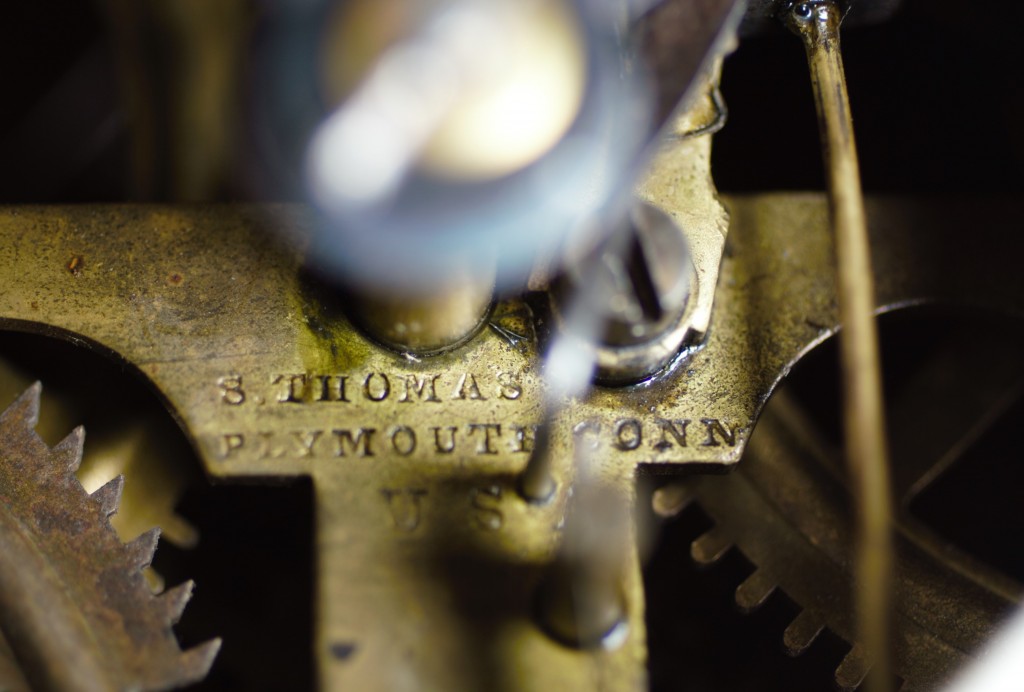
Unfortunately this just confirms the timeline provided by the paper label.
But unlike some of the examples I saw online and in books, the hammer is a complete circle rather than a crescent shape. Ah ha! Any notable difference is a clue.
With a bit more research, I was able to find out that the circular brass hammer was from the 1.241 middle period. Nuts. I was hoping for an indication that it was late in the production run since that coincides with the Civil War. But we are still in the running.
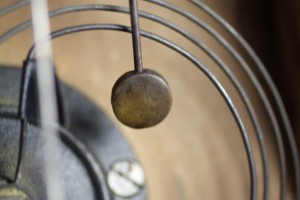
Step 4: Does the face give us any clues?
The face (dial) on older clocks can give us a wealth of information. Certainly on more modern clocks, the face may contain the manufacturer name, maybe a patent number and if you are lucky the place of origin. But the construction and design of the face on older clocks such as those produced by Seth Thomas can really help lock in a date. Is the face painted? Is it an applied paper face? What style are the numbers (roman numeral, art deco, raised lettering). Is it porcelain?
For well documented clocks such as this one, a significant secondary clue is the location and spacing of the winding holes. In the post for the moving eye Mammy clock, one big clue it was not a pre-1900 original was the incorrect placement of the winding holes. For the Seth Thomas clock the winding holes are about 9.5 mm in diameter. That matches the specification for the face of the entire run so not much help on narrowing the date.
Lucky for us the face is a painted with a distinctive pattern. The dial is metal with rings drawn around the minute marks and dots for the minute marks. ARG. That dial was in use form 1855 – 1860.
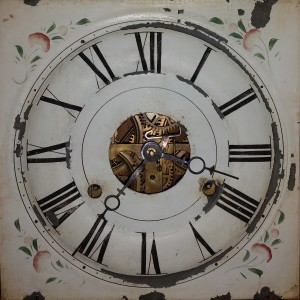
So based on the face and the hammer, I am having a hard time getting this clock into the American Civil War period between 1861 to 1865. Best guess it was produced just before the war.
NOTE: There is a fascinating history on Brass Movements starting with Chauncey Jerome. There was a robust market for selling cases and movements so the Seth Thomas clock is not entirely unique. The example on the Chauncey Jerome Wikipedia page is very, very close to this clock. Including the eagle which lends further credence to the hypothesis that the eagle imagery was in use well before the actual war.
Mechanical Elegance
I had never seen a weight driven mantel clock before. I have always wanted to build a clock so I am a little familiar with the principles of clock making but I have never seen a mantel version with weights.
The earliest forms of “modern” clocks were those that used counter weights to power them. You still see this in grandfather clocks and old wooden clocks. I also love that the two wooden pulley wheels that feed the weights. The core clock mechanism is brass as advertised. But the pulleys that feed the string to the weight are good old fashion wood and covered by two little wooden pieces delicately nailed down to cover the hole in the case. Simple and functional.
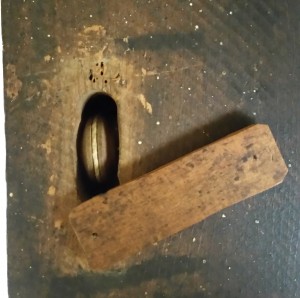
Lastly, my favorite part of the clock is the open space in the center of the dial. This allows you to see the mechanism in operation. When the clock strikes the hour you can actually see the groves indicating the number of times the clock will strike (1 time for 1:00, 2 times for 2:00, etc…). Watching the clock strike is both elegant and chaotic. It’s precise yet there is a hectic feel as the weights powers the advancement and strike the chime. It just seems like it should break:) But at this point, the clock has been around for 160 years, so you have to give it to those early engineers.
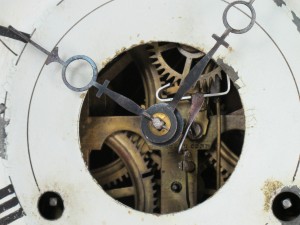
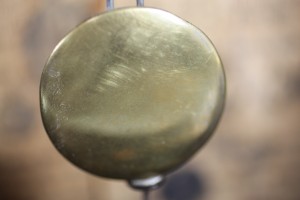
Enjoy!